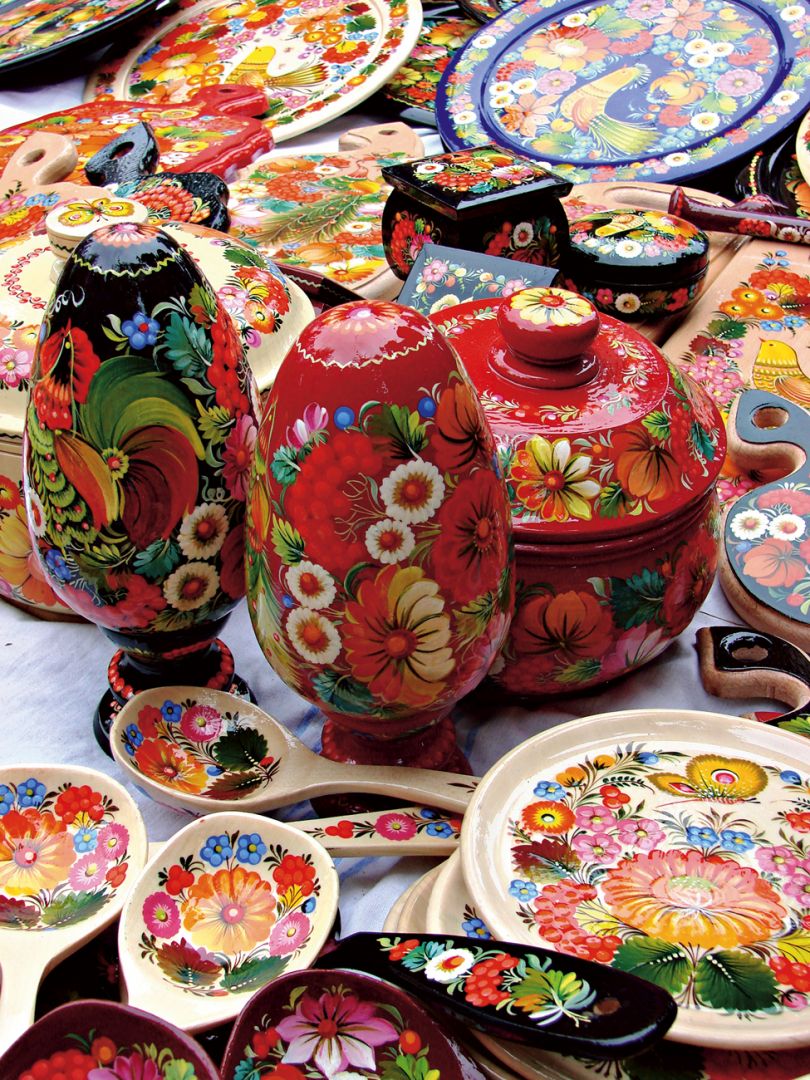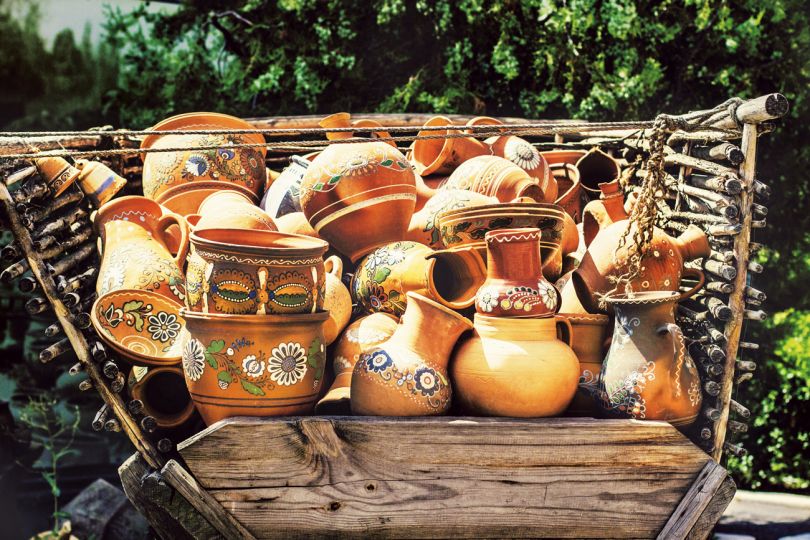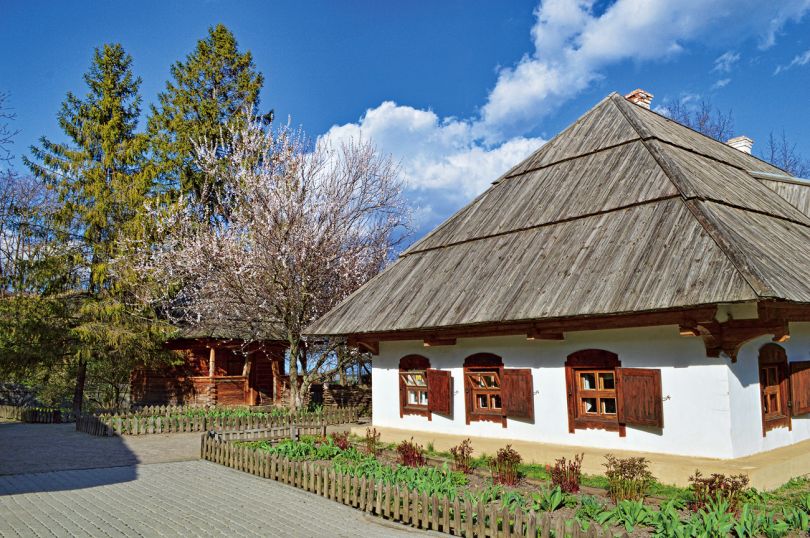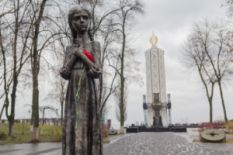Petrykivka: the capital of decorative painting
 Heritage. This town in Dnipro Region got its name after the Cossack Petryk, who first laid down a winter cabin on the bank of the river Chaplynka in 1756. Petryk was known to shelter bonded peasants fleeing from their lords. The story goes that local runaway peasants never knew serfdom again.
Heritage. This town in Dnipro Region got its name after the Cossack Petryk, who first laid down a winter cabin on the bank of the river Chaplynka in 1756. Petryk was known to shelter bonded peasants fleeing from their lords. The story goes that local runaway peasants never knew serfdom again.
Resettlers to Petrykivka from Ukraine’s historical provinces of Slobozhanshchyna, Poltavshchyna and Podilia brought with them the traditional craft of decorating the walls of their mud huts with splendid foliage-themed paintings. Each of the three regions boasted its own style of painting. These went on to form, in the mid-19th century, the unique Petrykivka decorative painting school. In 2013, Petrykivka painting was added to the UNESCO Representative List of the Intangible Cultural Heritage of Humanity.
What’s there now. To appreciate masterpieces of local art and attend a master class in pottery, visit the Petrykivka folk art centre with its 40-plus resident artists. The village is also home to a museum of ethnography and applied arts, as well as to a stud farm.
Situated close by are several other sites worth visiting, including the village of Hrechane 12 km away whose ethnography centre Halushkivka welcomes visitors all year round. You will have an opportunity to appreciate traditional Cossack cuisine, admire a vast collection of Christian crosses and ancient artifacts, and enjoy a Cossack funfair.
Opishnya: the capital of pottery
 Heritage. The scenic Cossack village on the bank of the Vorskla Rver has long been famed for its pottery business, with craft secrets passed down from generation to generation of local residents. By the turn of the 20th century this pottery capital of Ukraine boasted over 1,000 ceramists. Opishnya’s ceramic jugs, pots and bowls were in high demand abroad. The village would often be referred to as Ukraine’s Rome.
Heritage. The scenic Cossack village on the bank of the Vorskla Rver has long been famed for its pottery business, with craft secrets passed down from generation to generation of local residents. By the turn of the 20th century this pottery capital of Ukraine boasted over 1,000 ceramists. Opishnya’s ceramic jugs, pots and bowls were in high demand abroad. The village would often be referred to as Ukraine’s Rome.
What’s there now. Opishnya runs a national museum of Ukrainian pottery, which includes the Ceramology Institiute, several memorial estates once inhabited by local pottery masters, and an open-air sculpture exposition. The museum showcases examples of each and every pottery school across Ukraine. Attend a master class in ceramics and bring back your own pottery creation as a keepsake.
Dykanka: the capital of ethnic flair
 Heritage. The area where Dykanka, once made popular by the writer Nikolai Gogol, appeared used to be surrounded by dense oak forests. This wild thicket apparently gave the settlement its Ukrainian name (dykyi meaning wild).
Heritage. The area where Dykanka, once made popular by the writer Nikolai Gogol, appeared used to be surrounded by dense oak forests. This wild thicket apparently gave the settlement its Ukrainian name (dykyi meaning wild).
The first recorded mentioning of Dykanka dates back to 1658. In 1687, ownership rights to the village were transferred to Vasyli Kochubey, Chancellor of the Zaporozhian Host (Cossack Hetmanate), who would be eventually executed by Peter the Great for allegedly defaming Ivan Mazepa (something which Kochubey had never done, as transpired later). The Kochubey dynasty kept Dykanka in their ownership until 1917.
What’s there now. Fans of Gogol’s works are primarily interested in Dykanka’s St Nicholas and Trinity churches. It was in the St Nicholas church that the writer’s mother prayed before the icon of Nicholas the Wonderworker asking him to send her a healthy newborn child. She then named her son in honour of the saint.
The Trinity church is linked to Vakula the blacksmith, the protagonist of Gogol’s story Christmas Eve. It was apparently inside this place of worship that Vakula was commissioned to decorate the walls with scenes from the Apocalypse.
Dykanka’s other sights include the Kochubey oaks, each of them between 600 and 800 years old, under which Ivan Mazepa would date his beloved young goddaughter Motrya Kochubey. There is also a lilac grove planted in the 19th century by Count Viktor Kochubey on advice from the family doctor for the benefit of his daughter Hannusya, who was suffering from tuberculosis.
Velyki Sorochyntsi: the capital of fairs
 Heritage. The village began hosting seasonal fairs in the 17th century. In fact, the Sorochyntsi fair was never the larges or the most popular among such trade events; it became widely known exclusively thanks to Gogol’s novel of the same name.
Heritage. The village began hosting seasonal fairs in the 17th century. In fact, the Sorochyntsi fair was never the larges or the most popular among such trade events; it became widely known exclusively thanks to Gogol’s novel of the same name.
What’s there now. Velyki Sorochyntsi host Gogol’s literary memorial museum and the hotel cum museum Gogol Hutor. The picturesque village on the bank of the river Psel is crowned by the Church of the Transfiguration, commissioned by Danyla Apostol in Cossack Baroque style. Inside, you will find an ancient seven-tier icon screen standing 22 metres tall.
As for the fair itself, it has transformed into a nationwide phenomenon. Over 1,000 enterprises set out their stalls in the centre of the village every third week of August, with 500,000 visitors welcomed by local theatrical artists posing as characters of Gogol’s works.
Author: Liudmyla Semyvolos
Photo: shutterstock








